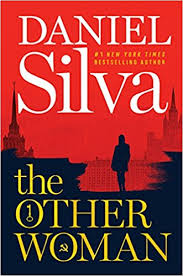Author Janet Skeslien Charles Shares the Story Behind The Paris Library
My novel is a love letter to libraries and librarians, reminding us that in the digital age, our libraries – our third space, our sanctuary, our source of facts in a fake-news world – are more vital than ever. And more than ever, they are under attack. Plus, read an excerpt of the first chapter of The Paris Library now!. Click the link above.

Based on the true World War II story of the heroic librarians at the American Library in Paris, The Paris Library is an unforgettable story of romance, friendship, family, and the power of literature to bring us together.
|
|
Paris, 1939: Young and ambitious Odile Souchet has it all: her handsome police officer beau and a dream job at the American Library in Paris. When the Nazis march into Paris, Odile stands to lose everything she holds dear, including her beloved library. Together with her fellow librarians, Odile joins the Resistance with the best weapons she has: books. But when the war finally ends, instead of freedom, Odile tastes the bitter sting of unspeakable betrayal.
Montana, 1983: Lily is a lonely teenager looking for adventure in small-town Montana. Her interest is piqued by her solitary, elderly neighbor. As Lily uncovers more about her neighbor’s mysterious past, she finds that they share a love of language, the same longings, and the same intense jealousy, never suspecting that a dark secret from the past connects them.
A powerful novel that explores the consequences of our choices and the relationships that make us who we are—family, friends, and favorite authors—The Paris Library shows that extraordinary heroism can sometimes be found in the quietest of places.
Author Janet Skeslien Charles, who herself worked at The American Library in Paris, has been travelling across the U.S. to tell the incredible true story that inspired her novel. Here, she shares this story with Library Journal readers.
 |
Courtesy of Janet Skeslien Charles |
“The American Library in Paris sits in the shadow of the Eiffel Tower. The largest English-language lending Library on the European continent, it has 4000 members and represents 60 countries. In 2020, the Library will celebrate its centennial.
I learned about the incredible true story of the librarians who worked at The American Library in Paris during World War II when I worked at the Library as a programs manager.
Our story starts in August of 1939. War is on the way to France. The U.S. ambassador advised, “In view of the situation prevailing in Europe, it is advisable that American citizens return to the United States.”
Dorothy Reeder, an American and the director of The American Library in Paris, refused to abandon the Library and prepared for the war by putting important documents and books in a safe.
In September 1939, three days after war was declared, Miss Reeder created the Soldiers Service. Books were shipped to English, French, and Czech soldiers as well as to the French foreign legion. She declared that ‘No other thing possesses that mystical faculty to make people see with other people’s eyes. The Library is a bridge of books between cultures.’
From September 1939 to May 1940, a total of 100,000 books were sent.
|
|
Courtesy of Janet Skeslien Charles |
Dorothy Reeder worked at the Library of Congress before moving to France in 1929.
At the Library, she began in the periodical section and worked her way up to the role of Directress. On June 12, 1940, just before the Nazis arrived in Paris, Miss Reeder sent her staff to the city of Angoulême, where they would be safe. She stayed at her post.
After the Nazis invaded the City of Light, they pillaged the Polish and Russian libraries in Paris. The Directress knew that it was only a matter of time before they arrived at the American Library. She knew she needed to protect the members, staff, and the collection.
She dealt with Dr. Fuchs, the Nazi ‘Library Protector’ who came to ‘inspect’ the Library.
‘Certain people may not enter,’ he stated, and Miss Reeder knew what he meant. Jewish patrons were no longer allowed to enter the Library.
Since Jewish members could no longer come to the Library, the Library went to them. Miss Reeder and her colleagues disobeyed the Nazis and hand-delivered books to Jewish members.
In the novel, Miss Reeder is prominently featured as the Directress of the Library. Along with Miss Reeder, several other real-life historical figures appear.
Clara de Chambrun was one of the original Library trustees, along with Edith Wharton. Originally from Ohio, Clara de Chambrun married a French count. The Countess earned a Ph.D. from the Sorbonne at the age of 48. She was a Shakespeare scholar as well as a novelist. She also translated Shakespeare’s work into French. During World War II, de Chambrun was the only trustee to remain in Paris. The others returned to the safety of the States. She was summoned to the office of the Nazi ‘Library Protector.’ The ALP had been denounced because its collection contained anti-German journals and political cartoons. She and the Nazi ‘Library Protector’ found a solution. The Countess would remove the cartoons from circulation, and was released.
Another real-life librarian that appears in the novel is Boris Netchaeff. Boris started at the Library as page and worked his way up to head librarian. Originally from Russia, he spoke several languages. During the Occupation, Boris was one of the librarians who hand delivered books to Jewish subscribers. It was a dangerous mission. Late one night, the Gestapo burst into the Netchaeff apartment and shot Boris in front of his wife and neighbors. He was taken prisoner and interrogated. Boris survived, and worked at the Library until he retired. I was lucky enough to be able to interview his daughter Helene for this book.
Miss Reeder, the Countess from Ohio, and Boris are the heart, soul, and life of the Library. I hope that you’ll enjoy reading about these courageous librarians as much as I enjoyed researching them.
My novel is a love letter to libraries and librarians, reminding us that in the digital age, our libraries – our third space, our sanctuary, our source of facts in a fake-news world – are more vital than ever. And more than ever, they are under attack. The Paris Library is a reminder that we must protect and appreciate what we have.
Bonne lecture ! Happy reading!
 |
Janet Skeslien CharlesPhoto by © Ricahrd Beban |
Janet Skeslien Charles first became interested in the incredible true story of the librarians who stood up to the Nazi “Book Protector” when she worked as the program’s manager at the American Library in Paris. Her novel, The Paris Library, will be published in June 2020. She divides her time between Montana and Paris.
SPONSORED BY

Wonderful wonderful book- so many heroes of the war still to be uncovered- thanks to Ms. Charles for bringing these heroes to light
Loved this audio book! Love the backdrop of facts during WW II. I had no idea there was such a library in Paris. The book has spurred me to look more into the library and it's characters. I almost abandoned this book as it was slow to develop characters and I found the audiobook accents hard to follow sometimes. Hang with this book! Really liked the author's notes at the end giving more info about the library and the real librarians from WW II. Thank you for featuring these unsung heros!!!
Loved this story. Thanks Janet for a captivating, unheard of before, this book tells this wonderful story. I am reading "Moonlight in Odessa". Loving it too. Another awesome read! Keep on writing such wonderful adventures of interesting women!! Sheila
Loved this story. It was finished in a few days and I was sad it was over. I always thought what I would of done, living in occupied France. More important, what am I doing today with life events. Touched home for me because I lived in Montana and visited Paris. Disappointed though that I did not know about the American Library, now I need to go back.
Hi, I am curious to know who wrote the letters betraying the library in the book The Paris Library?
Regards
Anne Brien
Fantastic read, but who wrote the betrayal letters? Margaret Saint James?
Thank you for a wonderful book. As a teacher at the International School of Paris in the 1990's, I loved the ALP. I could do research there that I used in my history classes.
Thank you, Janet Charles, for a great book.
Hi,
Is Froid, MT the historical town of residence for Odile? If not, how did you come to choose that small town in Montana?
Add Comment :-
RELATED
ALREADY A SUBSCRIBER? LOG IN
We are currently offering this content for free. Sign up now to activate your personal profile, where you can save articles for future viewing











